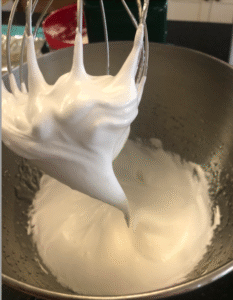Classic Lemon Meringue Pie
There’s something truly special about a lemon meringue pie. The crisp, buttery crust, the vibrant, tangy lemon filling, and the soft, toasted meringue topping come together in a delightful harmony of flavors and textures.
In today’s fast-paced world, taking the time to bake a pie from scratch is a heartfelt gesture. It speaks of care, tradition, and the joy of sharing something truly special. After all, nothing says love more than a pie made with love.
- Prep Time: 30
- Cook Time: 10
- Total Time: 40 minutes
- Yield: 8 1x
- Category: Pies
- Method: Stovetop, oven
- Cuisine: American
Ingredients
For the Pie Crust:
1 single 9-inch pie crust, blind-baked and cooled
For the Lemon Filling:
1 cup (200g) granulated sugar
2 tablespoons all-purpose flour
3 tablespoons cornstarch
1/4 teaspoon salt
1 1/2 cups (355ml) water
2 medium lemons, juiced and zested
2 tablespoons (28g) unsalted butter
4 large egg yolks, beaten
For the Meringue:
4 large egg whites
1/2 cup (100g) granulated sugar
Instructions
1. Prepare the Pie Crust:
-
Preheat your oven to 375°F (190°C).
-
Roll out your pie dough and fit it into a 9-inch pie pan. Click for my Essential Pie Crust Recipe
-
Line the crust with parchment paper and fill with pie weights or dried beans.
-
Bake for 15 minutes, remove weights and parchment, then bake for an additional 10 minutes or until golden brown.
-
Allow to cool completely.
2. Make the Lemon Filling:
-
In a medium saucepan, whisk together sugar, flour, cornstarch, and salt.
-
Stir in water, lemon juice, and lemon zest.
-
Cook over medium-high heat, stirring frequently, until the mixture comes to a boil.
-
Gradually whisk in the beaten egg yolks, stirring constantly.
-
Continue to cook until the mixture thickens.
-
Remove from heat and stir in butter until melted.
-
Pour the filling into the cooled pie crust.
3. Prepare the Meringue:
-
In a large bowl, beat egg whites until soft peaks form.
-
Gradually add sugar, continuing to beat until stiff peaks form.

4. Assemble and Bake:
-
Spread the meringue over the hot lemon filling, ensuring it touches the crust edges to prevent shrinking.
-
Use a spatula to create peaks in the meringue.
-
Bake at 350°F (175°C) for 10–12 minutes, or until the meringue is golden brown.
-
Remove from oven and cool at room temperature for 1 hour, then refrigerate for at least 2 hours before serving.
Notes
Tips for Success:
- Preventing a Soggy Crust: Ensure the crust is fully blind-baked and cooled before pouring in hot filling.
- Stiff Peaks Test: Your meringue is ready when it holds its shape and doesn’t slide off a spoon.
- No Weeping Meringue: Spread the meringue onto hot filling, not cooled, to seal and prevent moisture buildup.
- Seal the Edges: Spread the meringue so it touches the crust all around, creating a seal that helps prevent shrinking and moisture leakage.
- Bake Immediately: After apply the meringue, bake the pie right away to ensure proper setting and browning.
By following these steps, you can achieve a stable weep-free meringue topping that compliments your pie beautifully.
More about Meringue:
In the world of baking, meringue is a testament to the magic that simple ingredients can create. Comprising primarily of egg whites and sugar, this airy confection comes in various forms, each with its unique charm.
French meringue (used in this recipe), often considered the most straightforward, involves beating raw egg whites until they form soft peaks, then gradually adding sugar until stiff peaks develop. It’s light, airy, and perfect for folding into batters or baking into crisp cookies. However, its simplicity comes with a trade-off: it’s less stable and best used promptly after preparation.
On the other hand, Italian meringue is the epitome of stability and elegance. This method requires a bit more finesse, as it involves streaming hot sugar syrup into whipped egg whites, effectively cooking them in the process. The result is a glossy, firm meringue that holds its shape beautifully, making it ideal for toppings on pies, frostings, and confections like macarons. Its resilience allows it to withstand piping and toasting without collapsing.
While French meringue is like a spontaneous serenade, Italian meringue is a meticulously composed symphony. Both have their place in the baker’s repertoire, but if you’re seeking a meringue that combines beauty with durability, Italian meringue is your go-to choice. Click here for my recipe for Italian meringue.
FAQs
Q: If I am baking a lemon meringue pie for a dinner party, how far in advance can I bake it?
A: For optimal taste and texture it’s recommended to bake the lemon meringue pie not more than 2 days in advance. This ensures the crust remains crisp and the filling retains its intended consistency.
Q: How do I store my lemon meringue pie?
A: Your lemon meringue pie should be stored in the refrigerator and are best consumed within three to four days.
Q: Can I freeze lemon meringue pie?
A: Freezing is not recommended, as the meringue can become rubbery and the filling separate upon thawing. Best to enjoy the pie fresh or within a couple days of baking.
Q: Why is my lemon filling runny? A runny filling often results from undercooked or incorrect ingredient ratios, Ensure the filling reaches a full boil to activate the cornstarch, which thickens the mixture.
Tips for beginners:
- Start with a simplified recipe: opt for using a pre-made crust
- Practice Patience: Allow the pie to cool and set properly to achieve best texture and flavor
A Word of Encouragement for Beginner Bakers 💙
Every expert baker started as a beginner, just like you. The kitchen is your canvas, and each recipe is an opportunity to create something wonderful. Remember, baking is not just about following steps—it’s about infusing your creations with love and joy. Even if things don’t turn out perfectly, embrace the experience; each attempt brings you closer to mastery. As you embark on your baking journey, know that the sweetest successes often come from the most unexpected moments. 💙
Nutrition Disclaimer: The nutritional information provided is an estimate based on standard ingredients and serving sizes. Actual values may vary depending on specific products used and portion sizes. This information is provided for convenience and should not be considered medical or dietary advice.
Nutrition
- Serving Size: 1/8th of a 9-inch pie
- Calories: 385
- Fat: 15
- Carbohydrates: 60
- Protein: 4
Find it online: https://joyistalife.com/recipe/classic-lemon-meringue-pie/
